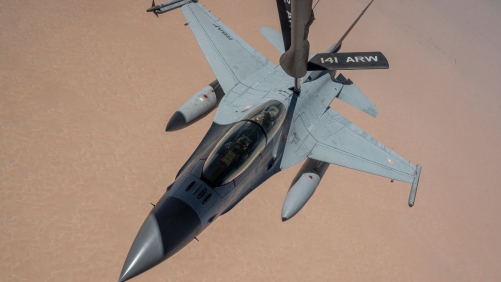The Ninth Air Force (Air Forces Central)’s 378th Air Expeditionary Wing recently conducted an exercise called Ballast Cannon 24.10 alongside the Royal Bahraini Air Force over the Arabian Peninsula. This routine exercise, which occurs nearly quarterly, aims to support the U.S. Air Force’s rapid expeditionary capabilities by integrating air-to-air training objectives between the two air forces. The exercise involved U.S. Air Force F-16 Fighting Falcons and a KC-135 Stratotanker from Aviano Air Base and Fairchild to maintain readiness to respond to crises and eliminate aerial threats.
The primary focus of the bilateral training was to strengthen the bonds between coalition forces and lay the groundwork for future engagements in support of the Combined Defense of the Arabian Peninsula. Training objectives included aerial refueling, coalition command and control, and tactical integration. The U.S. Air Force’s strong relationships within the U.S. Central Command area of responsibility allowed for regular and routine training, advancing the coalition’s ability to operate seamlessly across various warfighting domains. By incorporating partner nation integration training into the Ballast Cannon series, the exercise aimed to enhance strategic basing capabilities and strengthen coalition interoperability.
The exercise played a significant role in enhancing the strategic partnership between the U.S. and Bahrain, as well as other coalition forces in the region. The long-standing relationships and shared objectives between the Royal Bahraini Air Force and the U.S. Air Force allowed for effective collaboration and communication during the training. Through exercises like Ballast Cannon, both nations can improve their capabilities and better prepare for potential threats in the region.
The successful execution of Ballast Cannon 24.10 demonstrates the commitment of the U.S. Air Force and its coalition partners to maintaining readiness and interoperability in the Arabian Peninsula. By conducting regular training exercises like this one, the U.S. Air Force can ensure that it is prepared to respond to any potential threats or crises in the region. The exercise also highlighted the importance of cooperation and coordination between coalition forces to enhance the overall security and stability of the region.
Overall, Ballast Cannon 24.10 was a successful demonstration of the strong partnership between the U.S. Air Force and the Royal Bahraini Air Force. By working together and conducting joint exercises, both forces can enhance their capabilities and improve their ability to respond to threats in the region. The exercise also showcased the U.S. Air Force’s commitment to supporting its partners in the Arabian Peninsula and advancing regional security and stability. Through continued cooperation and collaboration, both nations can strengthen their defense capabilities and ensure a strong and united front against potential threats in the region.









